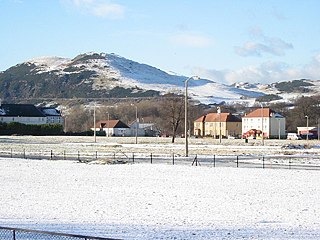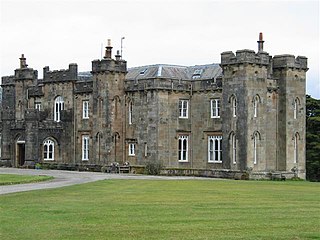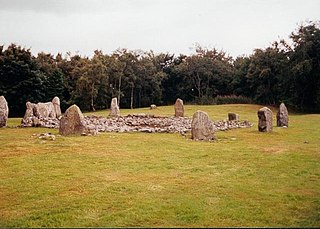
The Lewis chessmen or Uig chessmen, named after the island or the bay where they were found, are a group of distinctive 12th century chess pieces, along with other game pieces, most of which are carved from walrus ivory. Discovered in 1831 on Lewis in the Outer Hebrides of Scotland, they may constitute some of the few complete, surviving medieval chess sets, although it is not clear if a single complete period-accurate set can be assembled from the pieces. When found, the hoard contained 94 objects: 78 chess pieces, 14 tablemen and one belt buckle. Today, 82 pieces are owned and usually exhibited by the British Museum in London, and the remaining 11 are at the National Museum of Scotland in Edinburgh; one chesspiece is owned privately.

John Knox House, popularly known as John Knox's House, is a historic house in Edinburgh, Scotland, reputed to have been owned and lived in by Protestant reformer John Knox during the 16th century. Although his name became associated with the house, he appears to have lived in Warriston Close where a plaque indicates the approximate site of his actual residence.

The Royal Society of Edinburgh (RSE) is Scotland's national academy of science and letters. It is a registered charity that operates on a wholly independent and non-partisan basis and provides public benefit throughout Scotland. It was established in 1783. As of 2021, there are around 1,800 Fellows.

The Medea is a 1904 steam yacht preserved in the Maritime Museum of San Diego, United States. Named after Medea, the wife of Jason, she was built in a record 51 days on the Clyde at Alexander Stephen and Sons shipyard at Linthouse by John Stephen for William Macalister Hall of Torrisdale Castle, Scotland.
Torrisdale is a small village on the eastern coast of the Kintyre Peninsula of Scotland. The village is along Torrisdale Bay, an inlet of the Kilbrannan Sound. It is the location of Torrisdale Castle, a 19th-century castle that is now a tourist destination.

The Buckquoy spindle-whorl is an Ogham-inscribed spindle-whorl dating from the Early Middle Ages, probably the 8th century, which was found in 1970 in Buckquoy, Birsay, Orkney, Scotland. Made of sandy limestone, it is about 36 mm in diameter and 10 mm thick. It is the only known spindle-whorl with an Ogham inscription.

Little France is a suburb of Edinburgh, the capital of Scotland. It is on the A7, approximately 4 miles (6.4 km) south of the city centre.

Cairn na Burgh Beag is one of the Treshnish Isles in the Inner Hebrides, Scotland.

Skerray is a remote small crofting hamlet and fishing port on the north coast of Sutherland, Scotland. It is located 7+3⁄4 miles by road northeast of Tongue and 40+1⁄4 miles by road west of Thurso. Skerray is home to a community of artists and a group of tree planters.

Torrisdale Castle is a historic mansion residence, overlooking Torrisdale Bay, Argyll, south of Carradale, Kintyre, Scotland. The castle is situated at the edge of the village of Torrisdale. It is a category B listed building.

Dippen Bay is an embayment along Kilbrannan Sound on the east coast of the Kintyre Peninsula in Scotland. Coastal erosion has been documented at Dippen Bay as well as nearby Torrisdale Bay. The bay is located along the coast near the hamlet of Dippen.

Dippen is a hamlet on the east coast of the Kintyre Peninsula in Scotland. The community of Dippen is in close proximity to Dippen Bay. Roads on the east coast of Kintyre were greatly improved in the era circa 1776, when the settlement was known as Duppin.

Torrisdale is a remote hamlet on the western shore of Torrisdale Bay in Sutherland, Highland, on the north coast of Scotland. It is 3 kilometres (2 mi) west of Bettyhill.

The Whitecleuch Chain is a large Pictish silver chain that was found in Whitecleuch, Lanarkshire, Scotland in 1869. A high status piece, it is likely to have been worn as a choker neck ornament for ceremonial purposes. It dates from around 400 to 800 AD.

Milecastle 34 (Grindon) was a milecastle of the Roman Hadrian's Wall. There are no visible remains, but the site is within a small, tree-filled, walled enclosure located around 0.5 kilometres (0.31 mi) east of Sewingshields farm.
The Pier House Museum is a museum in Symbister, Whalsay, in the Shetland Islands of Scotland. The museum is located in the old Pier House, which was once the centre for trade with the Germans and the export of dried and salted fish to the Hanseatic League, an alliance of trading guilds that established and maintained a trade monopoly over much of Northern Europe between the 13th and 17th centuries. The Germans brought their goods, iron tools, seeds, salt and cloth to barter for dried and salted fish from the island. The old Hanseatic house which had been used by the Germans for several centuries until 1707, was refurbished for the museum, housing artefacts which date from the earlier trading period and providing an important insight into the economy of Shetland at the time. Architecturally it is described as "two-storeyed with crowstepped gables, and an external stone staircase." The house and port nearby are categorised officially as a category B Listed Building.

Mumrills was the site of the largest Roman fort on the Antonine Wall in Scotland. It is possible that Mumrills could exchange signals with Flavian Gask Ridge forts. Some believe Mumrills may have been the site of Wallace's defeat at the Battle of Falkirk. The farm at Mumrills was also used as an early site for the Falkirk Relief Church.
SS John Randolph was a Liberty ship built in the United States during World War II. She was named after John Randolph, a planter and a Congressman from Virginia who served in the House of Representatives at various times between 1799 and 1833 and the Senate from 1825 to 1827. He was also Minister to Russia under President Andrew Jackson in 1830.

Loanhead of Daviot stone circle is a recumbent stone circle in Aberdeenshire in lowland northeast Scotland. The circle consists of the recumbent stone with its flankers and a complete set of eight orthostats about 21 metres (69 ft) in diameter surrounding a low kerbed ring cairn which has an open court. However, the present appearance has in part been produced by substantial restoration after archaeological excavation in 1934, and in 1989 by the removal of the stones covering the central court.















